Cloud and Cloud Shadow Detection of GF-1 Images Based on the Swin-UNet Method
Abstract
:1. Introduction
2. Materials and Methods
2.1. Datasets and Preprocessing
2.2. Technical Route and Swin-UNet
2.3. Evaluation Index
2.4. Experimental Setting and Implementation Details
3. Results
3.1. Comparison of Results between Models and Distribution Analysis
3.2. Comparison of Different Land Cover Scenarios
4. Discussion
4.1. Influencing Factors of the Accuracy
4.2. Limitations and Prospects
5. Conclusions
- (1)
- Swin-UNet demonstrates exceptional performance in the detection of clouds and cloud shadows within GF-1 WFV optical imagery. It attains an average accuracy of 98.01% in cloud detection, with a recall rate of 96.84% and an F1-score of 95.48%, all surpassing results achieved by other models. Furthermore, its performance in cloud shadow detection is equally impressive.
- (2)
- Compared with CNN-based models such as U-Net, DeepLabV3+ and PSPNet, it is evident that Swin-UNet exhibits excellent performance, stability and robustness in the classification task of remote sensing images.
- (3)
- The network’s performance can be improved by adopting a more balanced sample proportion. In the future, the establishment of an extensive sample library and the integration of multiple feature relationships will hold significant research importance in the field of cloud and cloud shadow detection. Furthermore, Swin-UNet retains untapped potential for model improvement and migration applications, offering enhanced capabilities for the processing of high-resolution satellite data.
Author Contributions
Funding
Institutional Review Board Statement
Informed Consent Statement
Data Availability Statement
Acknowledgments
Conflicts of Interest
References
- Hansen, M.C.; Loveland, T.R. A review of large area monitoring of land cover change using Landsat data. Remote Sens. Environ. 2012, 122, 66–74. [Google Scholar] [CrossRef]
- Foley, J.A.; Defries, R.; Asner, G.P.; Barford, C.; Bonan, G.; Carpenter, S.R.; Stuart, C.F.; Coe, M.T.; Daily, G.C.; Gibbs, H.K.; et al. Global consequences of land use. Science 2005, 309, 570–574. [Google Scholar] [CrossRef] [PubMed]
- Vörösmarty, C.J.; McIntyre, P.B.; Gessner, M.O.; Dudgeon, D.; Prusevich, A.; Green, P.; Glidden, S.; Bunn, S.E.; Sullivan, C.A.; Liermann, C.R.; et al. Global threats to human water security and river biodiversity. Nature 2010, 467, 555–561. [Google Scholar] [CrossRef] [PubMed]
- Findell, K.L.; Berg, A.; Gentine, P.; Krasting, J.P.; Lintner, B.R.; Malyshev, S.; Santanello, J.A., Jr.; Shevliakova, E. The impact of anthropogenic land use and land cover change on regional climate extremes. Nat. Commun. 2017, 8, 989. [Google Scholar] [CrossRef] [PubMed]
- Haddeland, I.; Heinke, J.; Biemans, H.; Eisner, S.; Flörke, M.; Hanasaki, N.; Konzmann, M.; Ludwig, F.; Masaki, Y.; Schewe, J.; et al. Global water resources affected by human interventions and climate change. Proc. Natl. Acad. Sci. USA 2014, 111, 3251–3256. [Google Scholar] [CrossRef]
- Drusch, M.; Del Bello, U.; Carlier, S.; Colin, O.; Fernandez, V.; Gascon, F.; Hoersch, B.; Isola, C.; Laberinti, P.; Martimort, P.; et al. Sentinel-2: ESA’s Optical High-Resolution Mission for GMES Operational Services. Remote Sens. Environ. 2012, 120, 25–36. [Google Scholar] [CrossRef]
- Roy, D.P.; Wulder, M.A.; Loveland, T.R.; Woodcock, C.E.; Allen, R.G.; Anderson, M.C.; Helder, D.; Irons, J.R.; Johnson, D.M.; Kennedy, R.; et al. Landsat-8: Science and product vision for terrestrial global change research. Remote Sens. Environ. 2014, 145, 154–172. [Google Scholar] [CrossRef]
- Wulder, M.A.; Hilker, T.; White, J.C.; Coops, N.C.; Masek, J.G.; Pflugmacher, D.; Crevier, Y. Virtual constellations for global terrestrial monitoring. Remote Sens. Environ. 2015, 170, 62–76. [Google Scholar] [CrossRef]
- Storey, J.; Roy, D.P.; Masek, J.; Gascon, F.; Dwyer, J.; Choate, M. A note on the temporary misregistration of Landsat-8 Operational Land Imager (OLI) and Sentinel-2 Multi Spectral Instrument (MSI) imagery. Remote Sens. Environ. 2016, 186, 121–122. [Google Scholar] [CrossRef]
- Zhang, Y.C. Calculation of radiative fluxes from the surface to top of atmosphere based on ISCCP and other global data sets: Refinements of the radiative transfer model and the input data. J. Geophys. Res. Atmos. 2004, 109, D19. [Google Scholar] [CrossRef]
- Meng, Q.Y.; Wang, C.M.; Gu, X.F.; Sun, Y.X.; Zhang, Y.; Vatseva, R.; Jancso, T. Hot dark spot index method based on multi-angular remote sensing for leaf area index retrieval. Environ. Earth Sci. 2016, 75, 732–733. [Google Scholar] [CrossRef]
- Meng, Q.Y.; Liu, W.X.; Zhang, L.L.; Allam, M.; Bi, Y.X.; Hu, X.L.; Gao, J.F.; Hu, D.; Jancsó, T. Relationships between Land Surface Temperatures and Neighboring Environment in Highly Urbanized Areas: Seasonal and Scale Effects Analyses of Beijing, China. Remote Sens. 2022, 14, 4340. [Google Scholar] [CrossRef]
- Gong, J.Y.; Ji, S.P. Photogrammetry and Deep Learning. Acta Geod. Cartogr. Sin. 2018, 47, 693–704. [Google Scholar]
- An, Z.Y.; Shi, Z.W. Scene learning for cloud detection on remote-sensing images. IEEE J. Sel. Topics Appl. Earth Observ. Remote Sens. 2015, 8, 4206–4222. [Google Scholar] [CrossRef]
- Zhu, Z.; Wang, S.; Woodcock, C.E. Improvement and expansion of the fmask algorithm: Cloud, cloud shadow, and snow detection specifically for monitoring land cover change. Remote Sens. Environ. 2015, 159, 269–277. [Google Scholar] [CrossRef]
- Kegelmeyer, W.P. Extraction of Cloud Statistics from Whole Sky Imaging Cameras; Sandia National Lab. (SNL-CA): Livermore, CA, USA, 1994. [Google Scholar]
- Zhu, Z.; Woodcock, C.E. Object-based cloud and cloud shadow detection in Landsat imagery. Remote Sens. Environ. 2012, 118, 83–94. [Google Scholar] [CrossRef]
- Li, Z.; Shen, H.; Li, H.; Xia, G.; Gamba, P.; Zhang, L. Multi-feature combined cloud and cloud shadow detection in GaoFen-1 wide field of view imagery. Remote Sens. Environ. 2016, 191, 342–358. [Google Scholar] [CrossRef]
- Fisher, A. Cloud and Cloud-Shadow Detection in SPOT5 HRG Imagery with Automated Morphological Feature Extraction. Remote Sens. 2014, 6, 776–800. [Google Scholar] [CrossRef]
- Kang, X.; Gao, G.; Hao, Q.; Li, S. A Coarse-to-Fine Method for Cloud Detection in Remote Sensing Images. IEEE Geosci. Remote Sens. Lett. 2019, 16, 110–114. [Google Scholar] [CrossRef]
- Fu, H.; Shen, Y.; Liu, J.; He, G.; Chen, J.; Liu, P.; Qian, J. Cloud Detection for FY Meteorology Satellite Based on Ensemble Thresholds and Random Forests Approach. Remote Sens. 2018, 11, 95–99. [Google Scholar] [CrossRef]
- Hughes, M.; Hayes, D. Automated Detection of Cloud and Cloud Shadow in Single-Date Landsat Imagery Using Neural Networks and Spatial Post-Processing. Remote Sens. 2014, 6, 4907–4926. [Google Scholar] [CrossRef]
- Simonyan, K.; Zisserman, A. Very Deep Convolutional Networks for Large-Scale Image Recognition. Comput. Sci. 2014, 30, 330–335. [Google Scholar]
- Krizhevsky, A.; Sutskever, I.; Hinton, G.E. Imagenet classification with deep convolutional neural networks. Adv. Neural Inf. Process. Syst. 2012, 25, 84–90. [Google Scholar] [CrossRef]
- He, K.; Zhang, X.; Ren, S.; Sun, J. Deep Residual Learning for Image Recognition. In Proceedings of the IEEE Conference on Computer Vision and Pattern Recognition, Las Vegas, NV, USA, 26 June–1 July 2016; pp. 770–778. [Google Scholar]
- Zhu, X.X.; Tuia, D.; Mou, L.; Xia, G.S.; Zhang, L.; Xu, F.; Fraundorfer, F. Deep Learning in Remote Sensing: A Comprehensive Review and List of Resources. IEEE Geosci. Remote Sens. Mag. 2018, 5, 8–36. [Google Scholar] [CrossRef]
- Wu, X.; Shi, Z.W. Utilizing Multilevel Features for Cloud Detection on Satellite Imagery. Remote Sens. 2018, 10, 1853. [Google Scholar] [CrossRef]
- Yan, Z.; Yan, M.; Sun, H.; Fu, K.; Hong, J.; Sun, J.; Zhang, Y.; Sun, X. Cloud and cloud shadow detection using multilevel feature fused segmentation network. IEEE Geosci. Remote Sens. Lett. 2018, 15, 1600–1604. [Google Scholar] [CrossRef]
- Vaswani, A.; Shazeer, N.; Parmar, N.; Uszkoreit, J.; Jones, L.; Gomez, A.N.; Kaiser, Ł.; Polosukhin, I. Attention is all you need. Adv. Neural Inf. Process. Syst. 2017, 30, 1–11. [Google Scholar]
- Dosovitskiy, A.; Beyer, L.; Kolesnikov, A.; Weissenborn, D.; Zhai, X.; Unterthiner, T.; Dehghani, M.; Minderer, M.; Heigold, G.; Gelly, S. An image is worth 16x16 words: Transformers for image recognition at scale. arXiv 2020, arXiv:2010.11929. [Google Scholar]
- Zheng, S.; Lu, J.; Zhao, H.; Zhu, X.; Zhang, L. Rethinking Semantic Segmentation from a Sequence-to-Sequence Perspective with Transformers. In Proceedings of the IEEE Conference on Computer Vision and Pattern Recognition, Virtual, 20–25 June 2021; Volume 19, pp. 6881–6890. [Google Scholar]
- Liu, Z.; Lin, Y.; Cao, Y.; Hu, H.; Wei, Y.; Zhang, Z.; Lin, S.; Guo, B. Swin Transformer: Hierarchical Vision Transformer Using Shifted Windows. In Proceedings of the IEEE/CVF International Conference on Computer Vision, Montreal, QC, Canada, 11–17 October 2021; pp. 10012–10022. [Google Scholar]
- Cao, H.; Wang, Y.; Chen, J.; Jiang, D.; Zhang, X.; Tian, Q.; Wang, M. Swin-unet: Unet-like pure transformer for medical image segmentation. arXiv 2020, arXiv:2105.05537. [Google Scholar]
- He, X.; Zhou, Y.; Zhao, J.; Zhang, D.; Yao, R.; Xue, Y. Swin Transformer Embedding UNet for Remote Sensing Image Semantic Segmentation. IEEE Trans. Geosci. Remote Sens. 2022, 60, 1–15. [Google Scholar] [CrossRef]
- Malakar, S.; Ghosh, M.; Bhowmik, S.; Sarkar, R.; Nasipuri, M. A GA based hierarchical feature selection approach for handwritten word recognition. Neural Comput. Applic. 2020, 32, 2533–2552. [Google Scholar] [CrossRef]
- Bacanin, N.; Stoean, R.; Zivkovic, M.; Petrovic, A.; Rashid, T.A.; Bezdan, T. Performance of a Novel Chaotic Firefly Algorithm with Enhanced Exploration for Tackling Global Optimization Problems: Application for Dropout Regularization. Mathematics 2021, 9, 2705. [Google Scholar] [CrossRef]
- Lu, C.L.; Bai, Z.G. Characteristics and Typical Applications of GF-1 Satellite. In Proceedings of the 2015 IEEE International Geoscience & Remote Sensing Symposium: 2015 IEEE International Geoscience and Remote Sensing Symposium (IGARSS 2015), Milan, Italy, 26–31 July 2015; Institute of Electrical and Electronics Engineers: Piscataway, NJ, USA, 2015; Volume 15, pp. 1246–1249. [Google Scholar]
- Chen, L.C.; Zhu, Y.; Papandreou, G.; Schroff, F.; Adam, H. Encoder-Decoder with Atrous Separable Convolution for Semantic Image Segmentation. In Proceedings of the Computer Vision—ECCV 2018: 15th European Conference, Munich, Germany, 8–14 September 2018; Proceedings, p. VII. Springer: Berlin/Heidelberg, Germany; pp. 833–851. [Google Scholar]
- Chen, L.C.; Papandreou, G.; Schroff, F.; Adam, H. Rethinking atrous convolution for semantic image segmentation. arXiv 2017, arXiv:1706.05587. [Google Scholar]
- Zhao, H.; Shi, J.; Qi, X.; Wang, X.; Jia, J. Pyramid Scene Parsing Network. In Proceedings of the 2017 IEEE Conference on Computer Vision and Pattern Recognition: CVPR 2017, Honolulu, HI, USA, 21–26 July 2017; pp. 5987–6737. [Google Scholar]
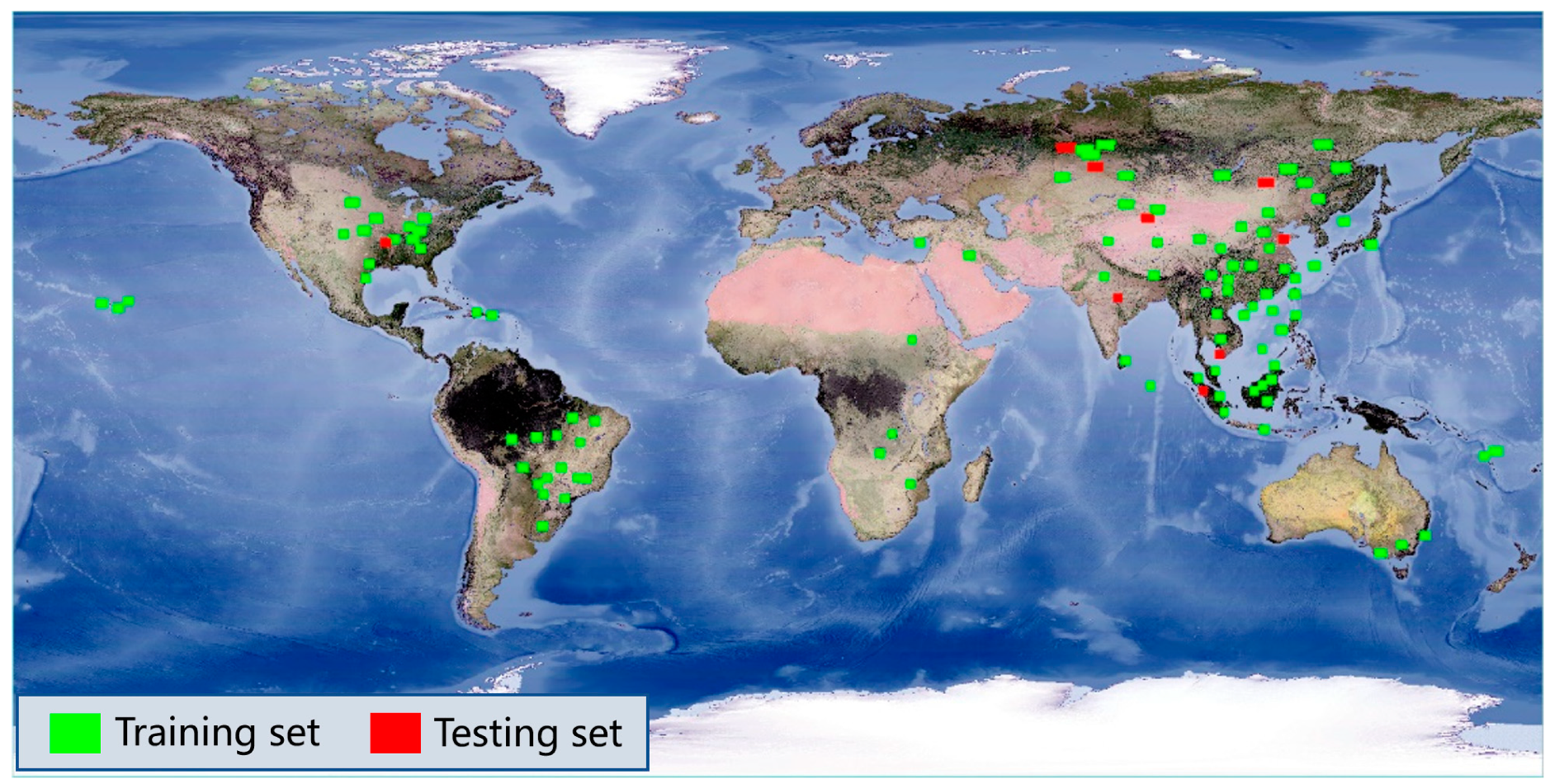


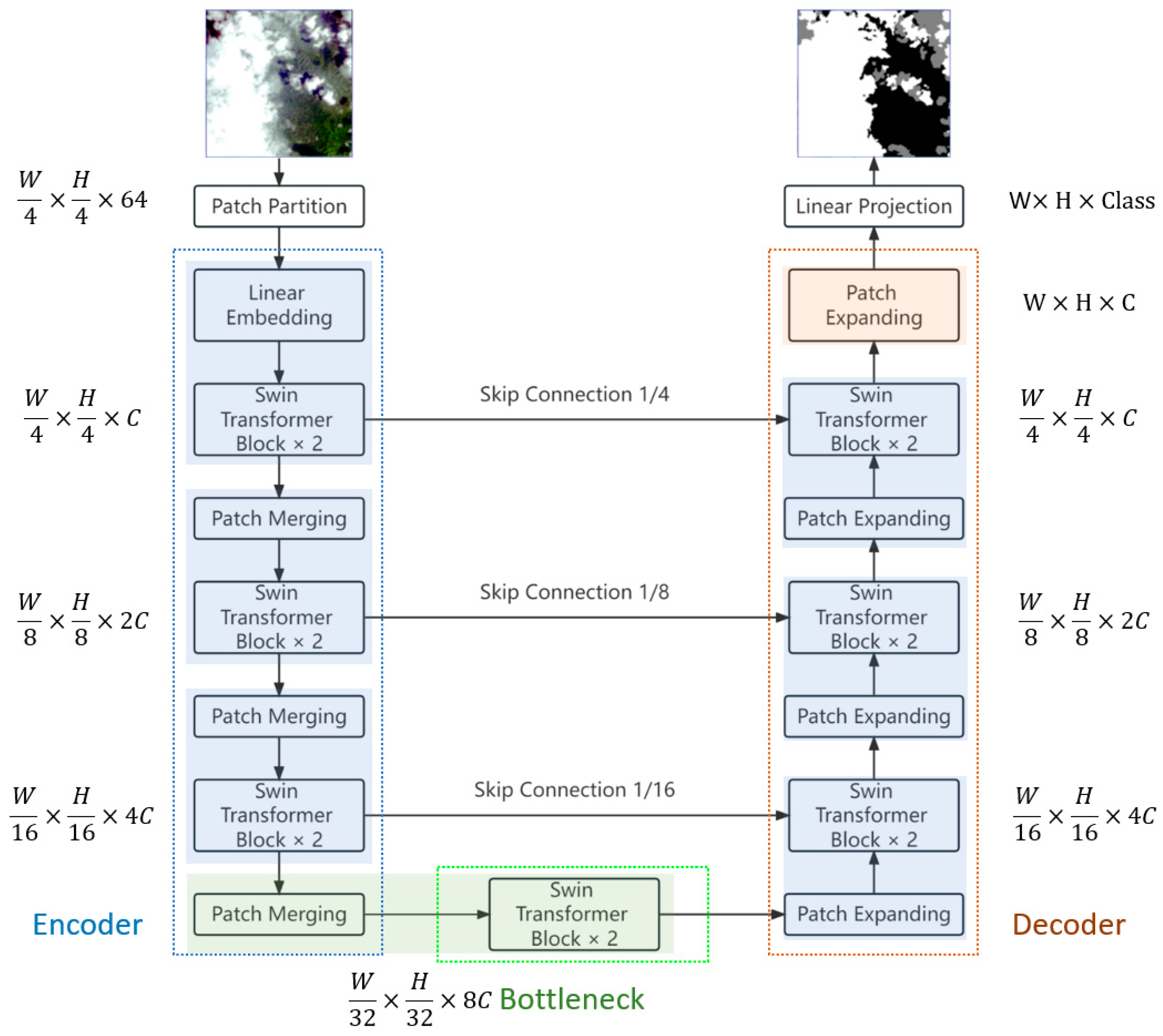



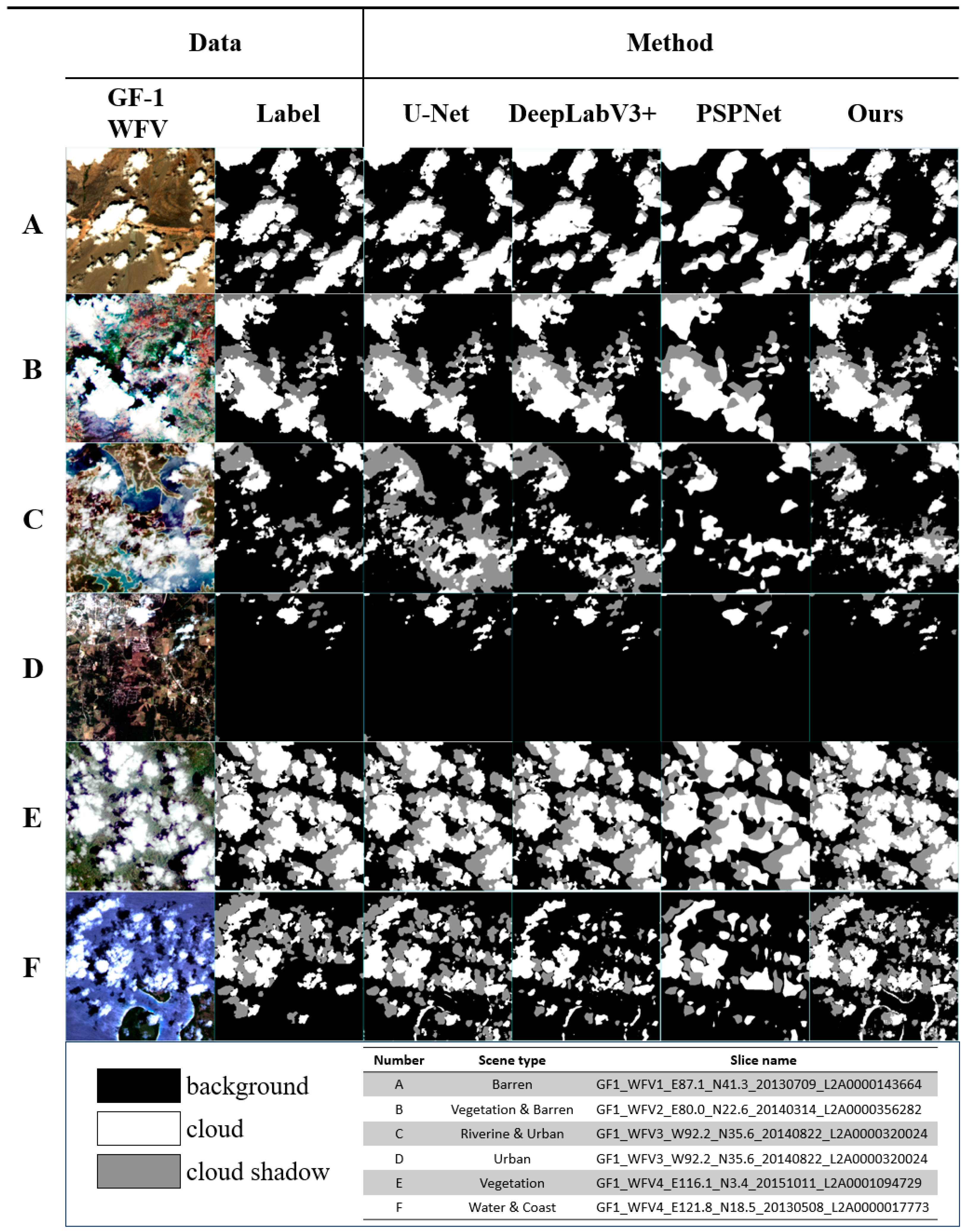
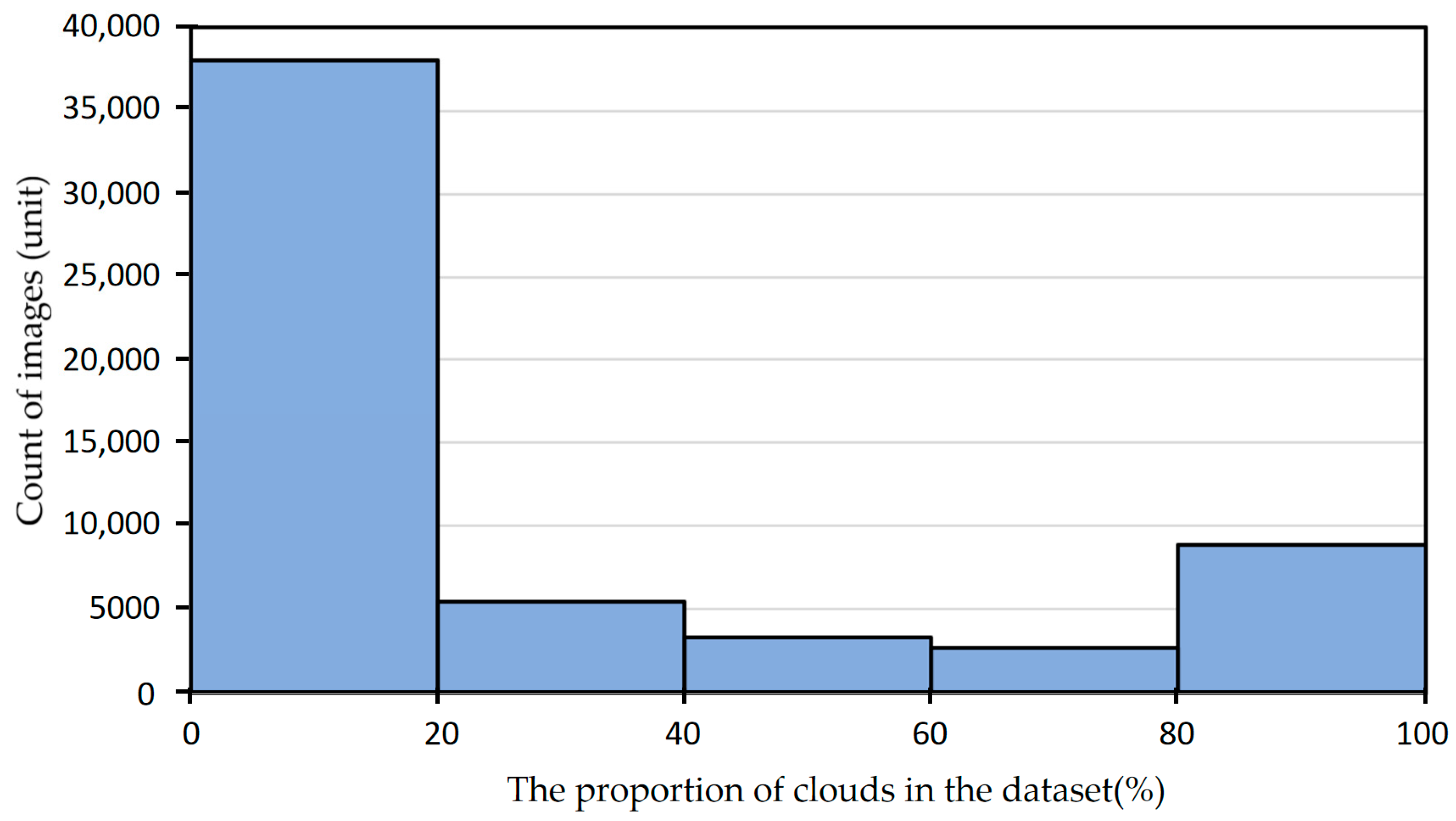

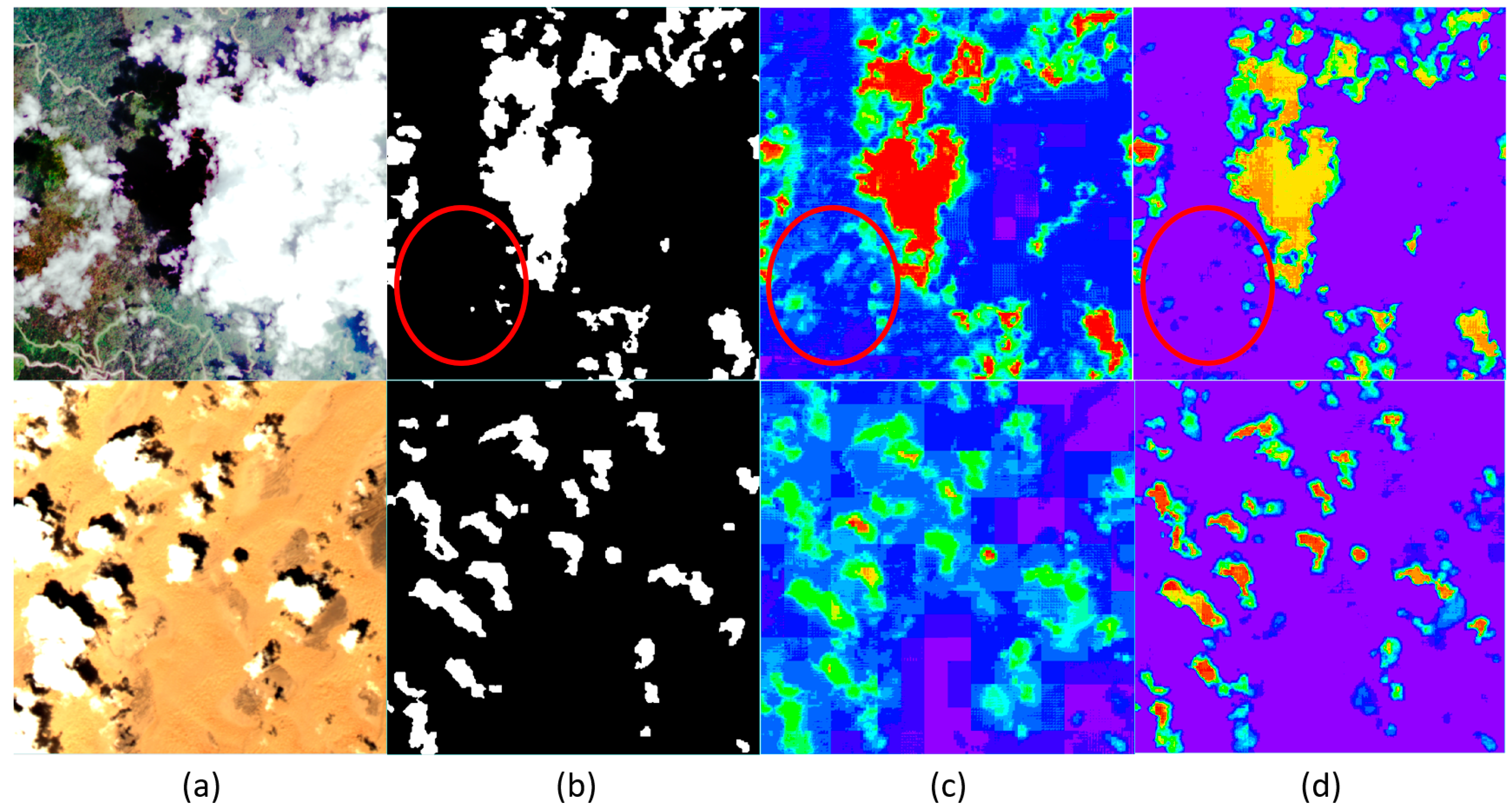
| Prediction | Reference | Result |
|---|---|---|
| Positive | Positive | True Positive |
| Negative | False Positive | |
| Negative | Positive | False Negative |
| Negative | True Negative |
| Parameter | Value |
|---|---|
| 0.9 | |
| 0.999 | |
| Base learning rate | 0.001 |
| Decay rate | 0.1 |
| Window size | 16 |
| Method | OA(%) | P(%) | F1-Score(%) | R(%) | IoU(%) |
|---|---|---|---|---|---|
| U-Net | 93.57 | 81.23 | 93.75 | 94.54 | 78.38 |
| DeepLabV3+ | 95.5 | 93.21 | 95.47 | 95.86 | 83.82 |
| PSPNet | 95.36 | 89.44 | 95.41 | 96.45 | 86.54 |
| Swin-UNet | 95.61 | 98.01 | 95.48 | 96.84 | 82.24 |
| Method | OA(%) | P(%) | F1-Score(%) | R(%) | IoU(%) |
|---|---|---|---|---|---|
| U-Net | 97.86 | 74.56 | 96.87 | 85.34 | 60.04 |
| DeepLabV3+ | 97.92 | 84.03 | 97.17 | 83.09 | 56.1 |
| PSPNet | 97.7 | 82.2 | 97.51 | 78.92 | 51.85 |
| Swin-UNet | 97.46 | 84.64 | 97.55 | 84.12 | 56.56 |
Disclaimer/Publisher’s Note: The statements, opinions and data contained in all publications are solely those of the individual author(s) and contributor(s) and not of MDPI and/or the editor(s). MDPI and/or the editor(s) disclaim responsibility for any injury to people or property resulting from any ideas, methods, instructions or products referred to in the content. |
© 2023 by the authors. Licensee MDPI, Basel, Switzerland. This article is an open access article distributed under the terms and conditions of the Creative Commons Attribution (CC BY) license (https://creativecommons.org/licenses/by/4.0/).
Share and Cite
Tan, Y.; Zhang, W.; Yang, X.; Liu, Q.; Mi, X.; Li, J.; Yang, J.; Gu, X. Cloud and Cloud Shadow Detection of GF-1 Images Based on the Swin-UNet Method. Atmosphere 2023, 14, 1669. https://doi.org/10.3390/atmos14111669
Tan Y, Zhang W, Yang X, Liu Q, Mi X, Li J, Yang J, Gu X. Cloud and Cloud Shadow Detection of GF-1 Images Based on the Swin-UNet Method. Atmosphere. 2023; 14(11):1669. https://doi.org/10.3390/atmos14111669
Chicago/Turabian StyleTan, Yuhao, Wenhao Zhang, Xiufeng Yang, Qiyue Liu, Xiaofei Mi, Juan Li, Jian Yang, and Xingfa Gu. 2023. "Cloud and Cloud Shadow Detection of GF-1 Images Based on the Swin-UNet Method" Atmosphere 14, no. 11: 1669. https://doi.org/10.3390/atmos14111669
APA StyleTan, Y., Zhang, W., Yang, X., Liu, Q., Mi, X., Li, J., Yang, J., & Gu, X. (2023). Cloud and Cloud Shadow Detection of GF-1 Images Based on the Swin-UNet Method. Atmosphere, 14(11), 1669. https://doi.org/10.3390/atmos14111669







